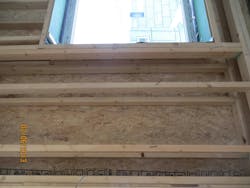Building Science: Hygrothermal Performance of a Double-stud Wall
Moisture problems within a building shell can be caused by a number of factors. These include excess interior moisture that is transported into the wall through air leakage and vapor drive, bulk water intrusion from leaks and wind-driven rain, capillary action from concrete-to-wood connections, and moist building materials such as wet siding caused by a rain event.
With the increasing thickness of the walls, moisture issues could potentially become a much bigger problem.
High-R wall assemblies are gaining popularity in the market due to programs like Passive House, Net Zero Energy Home challenges in several states, and highly incentivized retrofit programs.
Several contractors have successfully used “double wall” systems to more practically achieve higher R-values in thicker, framed walls.
A double wall typically consists of a load-bearing external frame wall usually constructed with 2-by-4 framing at 16-inch on center like a typical exterior frame wall using conventional methods. After the building is enclosed, an additional frame wall is constructed several inches inside the external load-bearing wall.
While several people have conducted extensive analysis on high-R assemblies using moisture modeling software, there has been little field research to validate the results. In response to this Steven Winter Associates Inc., Norwalk, Conn., monitored a double-stud assembly in Climate Zone 5A to determine the accuracy of moisture modeling and make recommendations to ensure durable, efficient assemblies.
To capture the performance through the full depth of these double-stud walls, temperature, relative humidity, and moisture content sensors were clustered in several locations throughout two stud bays—one on the north and one on the south. Interior temperature and relative humidity along with solar radiation on the south wall were also monitored.
North and south results
With respect to the south wall, the assembly performs well, stays below moisture content thresholds for mold growth, shows drying over the course of the year, and is predicted to experience reduced peak moisture content levels in consecutive years.
The north sheathing analysis, however, produces slightly more tentative conclusions. The wall does dry out well over the course of the year, and modeling suggests the overall assembly moisture content reduces in future years; however, the exterior sheathing experienced moisture content peaks of 21 percent and remained at approximately 20 percent for a couple months.
A sensitivity analysis was conducted to investigate the reasons for differences between actual and predicted peak moisture content levels in the north sheathing. The most significant match appears to be the case where a 1-percent moisture leak was assumed in the north bay.
A closer look at rain events over the course of the year suggest penetration of bulk water past the weather barrier into the sheathing by wind-driven rain.
To deal with wind-driven rain and prevent the sheathing from wetting via bulk water leaks, a more robust quality-control system for properly installing the weather-resistive barrier is recommended. This could include better detailing in the construction drawings, closer attention to the continuity of the drainage plane, proper sealing of any penetrations made in the weather-resistive barrier, or the addition of a rain screen assembly to separate the siding from the sheathing for a better capillary break.
Additional monitoring is underway in two test homes in upstate New York in cooperation with the New York State Energy Research and Development Authority. Double-stud walls are again the method of construction in both homes, one with 12 inches of dense-packed cellulose, the other with 3.5 inches of closed cell spray polyurethane foam, and the remaining dense-packed cellulose. Results of the study will be available in fall 2014.
Lessons learned
High R-value wall assemblies like double-stud walls constructed with the structural sheathing on the exterior of the insulation should employ a vented cladding to assist in drying of that layer.
Preventing moisture from getting into the walls through proper air sealing, implementation of the water-resistant barrier on the exterior, and control of interior moisture levels is crucial to ensure a durable assembly.
Proper ventilation and dehumidification of the space immediately after construction is complete will aid in preventing moisture buildup in the building assembly components. PR
--
Lois Arena, PE, CPHD, is a senior mechanical engineer for Steven Winter Associates, Norwalk, Conn. She can be reached at 203.857.0200 or [email protected].
